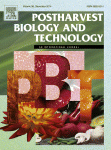Ver ítem
- xmlui.general.dspace_homeCentros Regionales y EEAsCentro Regional Entre RíosEEA ConcordiaArtículos científicosxmlui.ArtifactBrowser.ItemViewer.trail
- Inicio
- Centros Regionales y EEAs
- Centro Regional Entre Ríos
- EEA Concordia
- Artículos científicos
- Ver ítem
Characterization of sensitivity of grove and packing house isolates of Penicillium digitatum to pyrimethanil
Resumen
In most northeast Argentinean citrus packing houses, postharvest fungicide treatments are based onthe use of thiabendazole and imazalil. However, these fungicides have been used in a manner highlyconducive to the selection and proliferation of resistant biotypes of Penicillium digitatum, the main fruitdecay fungus in the area. Recently, a new fungicide, pyrimethanil (PYR), was introduced to control molds.Aims of this study were to determine the baseline
[ver mas...]
In most northeast Argentinean citrus packing houses, postharvest fungicide treatments are based onthe use of thiabendazole and imazalil. However, these fungicides have been used in a manner highlyconducive to the selection and proliferation of resistant biotypes of Penicillium digitatum, the main fruitdecay fungus in the area. Recently, a new fungicide, pyrimethanil (PYR), was introduced to control molds.Aims of this study were to determine the baseline sensitivities for PYR against isolates of P. digitatumconsidering its use in the region is not yet widespread and to evaluate the control of the fungus in vivo.One hundred and nine (109) P. digitatum isolates were collected from diseased fruit within citrus groves(43 isolates) and packing houses (66 isolates). EC50was determined for each isolate by measuring colonydiameters on different agar dilutions of the fungicide. The mean EC50value of the green mold isolatescollected from the groves was 0.14 ± 0.03 mg L−1while the mean EC50of those collected from packinghouses was 0.13 ± 0.05 mg L−1. No resistant isolates were found in the field where the fungicide is notused, while one isolate originated from a packing house showed an EC50of 3.40 mg L−1, 26-fold higherthan the mean level. This isolate was collected from lemons stored in cool rooms of a packing house wherePYR had not been used. Fruit decay by sensitive isolates was reduced approximately 80% by PYR appliedat 500–600 mg L−1by immersion for 60 s at room temperature to inoculated oranges and mandarins. Incontrast, the resistant isolate was not controlled by PYR applied at 1000 mg L−1. Thus, the introduction ofPYR applied into packing houses should be done carefully and control strategies should be implementedin order to minimize the development of resistant isolates.
[Cerrar]

Fuente
Postharvest biology and technology 98 : 1–6. (2014)
Fecha
2014
ISSN
0925-5214
Formato
pdf
Tipo de documento
artículo
Palabras Claves
Derechos de acceso
Restringido
 Excepto donde se diga explicitamente, este item se publica bajo la siguiente descripción: Creative Commons Attribution-NonCommercial-ShareAlike 2.5 Unported (CC BY-NC-SA 2.5)
Excepto donde se diga explicitamente, este item se publica bajo la siguiente descripción: Creative Commons Attribution-NonCommercial-ShareAlike 2.5 Unported (CC BY-NC-SA 2.5)

